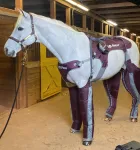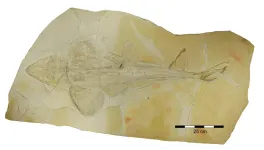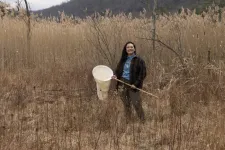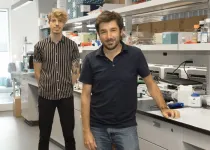(Press-News.org) Images
Ankle exoskeletons that can help people extend their endurance are a step closer to reality with a new control algorithm, developed at the University of Michigan, that could enable future exoskeletons to automatically adapt to individual users and tasks. This would reduce or eliminate the need for manual recalibration.
Current exoskeletons are limited because they must be tailored to a single user performing a single task, like walking in a straight line. Any changes require a lengthy set of manual readjustments. The new control algorithm demonstrates the ability to handle different speeds, as well as changes in gait between running and walking. It could pave the way for exoskeletons that are better able to handle the uncertainties of the real world.
"This particular type of ankle exoskeleton can be used to augment people who have limited mobility," said Leia Stirling, U-M associate professor of industrial and operations engineering and robotics and senior author of the study published in the journal PLOS ONE.
"That could be an older adult who wouldn’t normally be able to walk to the park with their grandkids. But wearing the system, they now have extra assistance that enables them to do more than they could before."
The control algorithm directly measures how quickly muscle fibers are expanding and contracting to determine the amount of chemical energy the muscle is using while doing its work. Then, it compares that measurement with a biological model to determine the best way to assist.
Measuring muscle physiology directly is a key departure from current methods, which use broader measures of motion. Going straight to the source of motion could result in more accurate measurements over a larger range of movements with far less computing power required.
Stirling and first author Paul Pridham, senior research area specialist in industrial and operations engineering, zeroed in on the ankle because it plays a key role in mobility. Assisting the muscles in the ankle could have a dramatic impact on our ability to walk further and faster.
Since the research was done during COVID-19 restrictions, testing with human participants wasn't possible. Instead, the team used data on existing ankle exoskeleton devices and muscle dynamics from previous studies to simulate, test and adjust the algorithm to be more responsive to changes in speed and gait.
Human testing is an important next step, and will require the measurement of muscle fibers in real time using ultrasound. While much work and refinement remains, the researchers are confident that the new avenue of research will one day help people on the ground.
"This has the potential to help just about anyone," Pridham said. "From someone who walks a lot for their job, to individuals in the military that perform tasks for long periods of time, to people with muscular disorders that need some extra assistance, and the elderly who need help day-to-day."
The study was funded by the Under Secretary of Defense for Research and Engineering under Air Force Contract No. FA8702-15-D-0001.
Study: Ankle exoskeleton torque controllers based on soleus muscle models (DOI: 10.1371/journal.pone.0281944)
END
Responsive ankle exoskeleton algorithm handles changes in pace and gait
The algorithm uses direct muscle measurement, with the potential to seamlessly support a user who switches between walking and running
2023-02-28
ELSE PRESS RELEASES FROM THIS DATE:
Obesity makes it harder to diagnose and treat heart disease
2023-02-28
ROCHESTER, Minn. — Being overweight impacts your heart health in more ways than you might think. A new JACC review paper from Mayo Clinic outlines how obesity affects the common tests used to diagnose heart disease and impacts treatments. Cardiovascular disease is the leading cause of death in the U.S. and globally, yet it is largely preventable.
"Excess fat acts as a kind of filter and can skew test readings to under-or overdiagnosis," says senior author Francisco Lopez-Jimenez, M.D., director of preventive cardiology at Mayo Clinic. "Obesity affects ...
Shirley Ryan AbilityLab receives department of defense grant for first-of-its-kind study on neurally controlled bionic legs with osseointegration
2023-02-28
CHICAGO — Feb. 28, 2023 — Today, millions of individuals across the world live with limb loss, including thousands of combat-injured service men and women. Although significant progress has been made in the durability, control and function of prosthetic devices, they lack complete integration into the body.
Now, with the award of a $1.5 million grant from the Department of Defense Congressionally Directed Medical Research Program (CDMRP), Shirley Ryan AbilityLab — the top-ranked physical medicine and rehabilitation hospital — ...
BU researchers receive $1.3m EPA grant to advance climate resilience among Mystic River communities
2023-02-28
FOR IMMEDIATE RELEASE
February 28, 2023
Contact:
Jillian McKoy, jpmckoy@bu.edu
Michael Saunders, msaunder@bu.edu
##
BU Researchers Receive $1.3M EPA Grant to Advance Climate Resilience among Mystic River Communities
The three-year project aims to identify and address the cumulative impacts of chemical hazards and climate change that affect the 21 communities surrounding the Mystic River Watershed.
The 21 communities that surround Greater Boston’s Mystic River Watershed are exposed to many of the central threats of climate change, including urban heat islands and coastal and inland flooding, while also confronting multiple chemical exposures.
Now, with ...
Artificial intelligence with a human touch
2023-02-28
Despite the remarkable progress in artificial intelligence (AI), several studies show that AI systems do not improve radiologists' diagnostic performance. In fact, diagnostic errors contribute to 40,000 - 80,000 deaths annually in U.S. hospitals. This lapse creates a pressing need: Build next-generation computer-aided diagnosis algorithms that are more interactive to fully realize the benefits of AI in improving medical diagnosis.
That’s just what Hien Van Nguyen, University of Houston associate professor of electrical and computer engineering, is doing with a new $933,812 grant from the National Cancer Institute. He will focus on ...
Compression treatment could relieve horses’ painful swollen limbs
2023-02-28
Researchers from North Carolina State University have taken technology aimed at helping humans suffering from lymphedema – in which the accumulation of excess lymph fluid causes swollen limbs – and developed a medical device to aid horses suffering from the same condition. In a pilot study the device, called the EQ Press, was successful in moving fluid up the limbs and into the lymph nodes. This could lead to relief for horses with chronic conditions, as well as with temporary swelling due to injury or inactivity.
“Across the board, ...
Jurassic shark – Shark from the Jurassic period was already highly evolved
2023-02-28
Cartilaginous fish have changed much more in the course of their evolutionary history than previously believed. Evidence for this thesis has been provided by new fossils of a ray-like shark, Protospinax annectans, which demonstrate that sharks were already highly evolved in the Late Jurassic. This is the result of a recent study by an international research group led by palaeobiologist Patrick L. Jambura from the Department of Palaeontology at the University of Vienna, which was recently published in the journal Diversity.
Cartilaginous fishes (sharks, rays, and ratfish) ...
Flower power: Research highlights the role of ants in forest regeneration
2023-02-28
BINGHAMTON, N.Y. -- Ants play a key role in forest regeneration, according to a new paper from Binghamton University, State University of New York.
Walk through an old growth forest in early spring, and you’ll be dazzled by wildflowers, their jewel-like tones shining from the forest floor.
But in newer forests, spring ephemerals such as trillium, wild ginger, violets and bloodroot are in shorter supply. The reason may lie with some less-flashy forest residents: Aphaenogaster sp., or the woodland ant.
“Not a lot of people have heard of them, but they are ...
StemJournal welcomes new Co-Editor-in-Chief Giorgia Quadrato, PhD
2023-02-28
Amsterdam, NL, February 28, 2023 – StemJournal (STJ), published by IOS Press, is pleased to announce the appointment of new co-Editor-in-Chief, Giorgia Quadrato, PhD, effective immediately. Dr. Quadrato joins co-Editor-in-Chief Niels Geijsen, PhD, and an eminent international editorial board, who are dedicated to the success of the world’s international journal in stem cell research and therapy, and part of IOS Press’ StemHub.
An outstanding scientist and researcher, Giorgia Quadrato, is an Assistant Professor of Stem Cell Biology and Regenerative Medicine at the Keck School of Medicine ...
HIV reservoirs are established earlier than expected
2023-02-28
Montreal, February 28, 2023—For the first time in humans, a research team has shown that, as early as the first days of infection, HIV is able to create reservoirs where it will hide and persist during antiretroviral therapy.
Until now, the scientific community did not know exactly when or how these viral reservoirs—the existence of which is a major obstacle to curing HIV—are established in human beings.
In a study published in the journal Immunity, scientists led by Nicolas Chomont, a researcher at the CHUM Research Centre (CRCHUM) and professor at Université de Montréal, found ...
Social media posts around solar geoengineering ‘spill over’ into conspiracy theories
2023-02-28
Researchers from the University of Cambridge have analysed more than 800,000 tweets and found that negative emotions expressed about geoengineering – the idea that the climate can be altered using technology – can easily fall into conspiracy.
The researchers analysed tweets 2009 and 2021 tagged with #geoengineering. They used a combination of natural language processing, deep learning and network analysis to explore how public emotions, perceptions and attitudes have changed over a 13-year period.
The researchers found that there is a large amount of ‘spillover’ between geoengineering ...
LAST 30 PRESS RELEASES:
Making lighter work of calculating fluid and heat flow
Normalizing blood sugar can halve heart attack risk
Lowering blood sugar cuts heart attack risk in people with prediabetes
Study links genetic variants to risk of blinding eye disease in premature infants
Non-opioid ‘pain sponge’ therapy halts cartilage degeneration and relieves chronic pain
AI can pick up cultural values by mimicking how kids learn
China’s ecological redlines offer fast track to 30 x 30 global conservation goal
Invisible indoor threats: emerging household contaminants and their growing risks to human health
Adding antibody treatment to chemo boosts outcomes for children with rare cancer
Germline pathogenic variants among women without a history of breast cancer
Tanning beds triple melanoma risk, potentially causing broad DNA damage
Unique bond identified as key to viral infection speed
Indoor tanning makes youthful skin much older on a genetic level
Mouse model sheds new light on the causes and potential solutions to human GI problems linked to muscular dystrophy
The Journal of Nuclear Medicine ahead-of-print tip sheet: December 12, 2025
Smarter tools for peering into the microscopic world
Applications open for funding to conduct research in the Kinsey Institute archives
Global measure underestimates the severity of food insecurity
Child survivors of critical illness are missing out on timely follow up care
Risk-based vs annual breast cancer screening / the WISDOM randomized clinical trial
University of Toronto launches Electric Vehicle Innovation Ontario to accelerate advanced EV technologies and build Canada’s innovation advantage
Early relapse predicts poor outcomes in aggressive blood cancer
American College of Lifestyle Medicine applauds two CMS models aligned with lifestyle medicine practice and reimbursement
Clinical trial finds cannabis use not a barrier to quitting nicotine vaping
Supplemental nutrition assistance program policies and food insecurity
Switching immune cells to “night mode” could limit damage after a heart attack, study suggests
URI-based Global RIghts Project report spotlights continued troubling trends in worldwide inhumane treatment
Neutrophils are less aggressive at night, explaining why nighttime heart attacks cause less damage than daytime events
Menopausal hormone therapy may not pose breast cancer risk for women with BRCA mutations
Mobile health tool may improve quality of life for adolescent and young adult breast cancer survivors
[Press-News.org] Responsive ankle exoskeleton algorithm handles changes in pace and gaitThe algorithm uses direct muscle measurement, with the potential to seamlessly support a user who switches between walking and running





